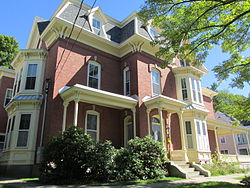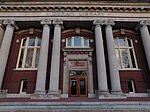United States historic place
| Main Street–Frye Street Historic District | |
| U.S. National Register of Historic Places | |
| U.S. Historic district | |
 10 Frye Street 10 Frye Street | |
  | |
| Location | Frye, College and Main Sts., Lewiston, Maine |
|---|---|
| Coordinates | 44°6′22″N 70°12′40″W / 44.10611°N 70.21111°W / 44.10611; -70.21111 |
| Area | 17.4 acres (7.0 ha) |
| Architectural style | Second Empire, Victorian |
| NRHP reference No. | 08001355 |
| Added to NRHP | January 23, 2009 |
The Main Street–Frye Street Historic District is a historic district comprising houses on Frye Street and parts of College Street and Main Street in Lewiston, Maine. This area was part of the most fashionable residential district of the city in the second half of the 19th century, and was home to many of the city's elite. Its architectural styles are diverse, with a significant number of homes designed by local architect George M. Coombs. The district was added to the National Register of Historic Places in 2009.
Description and history
The Main Street–Frye Street Historic District encompasses 37 houses, primarily located on two blocks of Main and Frye Streets, between the city's downtown area and the early portions of the Bates College campus. The district extends on the east side of Main Street, between Mountain Avenue and Whipple Street, and includes three houses on the west side, north of Central Street. It includes all properties on Frye Street, running east from Main to College Streets, and three adjacent houses on the west side of College Street north of Frye. Many of these properties are now part of the Bates campus.
Lewiston was developed as a major textile center beginning in the 1830s by John and William Frye. The Franklin Company, which operated the mills, owned much of the land in the area, and laid out its streets. Bates College was founded in 1864, named for later mill owner Benjamin E. Bates. The area in between the city's downtown and the Bates campus was originally farmland, which began to be sold off for development in 1851. One of the first houses built on Frye Street was that of Oren B. Cheney, the founder of Bates College, in 1866. The Frye Street area became popular with many of the city's business and political elites because it lay just beyond company-owned lands, and was close to the college. As a result, a significant number of architecturally high-quality houses were built, from Greek Revival and Gothic Revival cottages to elaborate Second Empire style mansions. There are 12 Queen Anne Victorians, and 11 Colonial Revival houses. Twelve of the district's 37 houses were designed by local architect George M. Coombs, providing a distinctive view of his residential designs. The area contains the Sen. William P. Frye House and the James C. Lord House, both previously listed on the National Register. Bates College now owns most of the houses on Frye Street.
See also
References
- ^ "National Register Information System". National Register of Historic Places. National Park Service. April 15, 2008.
- ^ "NRHP nomination for Main Street-Frye Street Historic District". National Park Service. Retrieved November 3, 2015.
| Bates College | ||
|---|---|---|
| Campus |  | |
| History | ||
| Athletics | ||
| Student life | ||
| U.S. National Register of Historic Places | |
|---|---|
| Topics | |
| Lists by state |
|
| Lists by insular areas | |
| Lists by associated state | |
| Other areas | |
| Related | |
- Historic districts in Androscoggin County, Maine
- Bates College
- Buildings and structures in Lewiston, Maine
- School buildings on the National Register of Historic Places in Maine
- University and college academic buildings in the United States
- Culture of Lewiston, Maine
- Historic districts on the National Register of Historic Places in Maine
- National Register of Historic Places in Lewiston, Maine
- Second Empire architecture in Maine